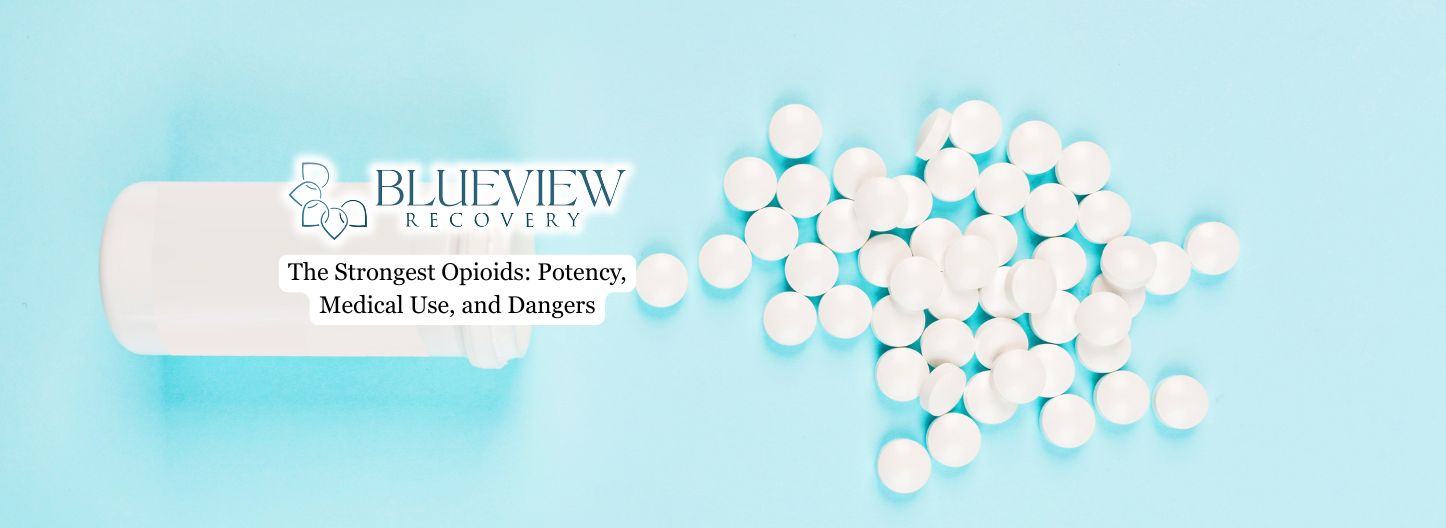Opioids are strong medications used to relieve pain, but not all are equally powerful or safe. They work by attaching to pain receptors in the brain and spinal cord, thereby reducing the body’s perception and response to pain. Some are derived from natural plant sources, while others are synthesized in laboratories. The strength and risk of each drug depend on how it affects the brain and its duration of action in the body.
This article breaks down which opioids are considered the strongest, how they’re used in medicine, and why their potency can make them especially dangerous or addictive when misused.

Measuring Potency
Doctors measure how strong an opioid is by comparing it to morphine, using a scale called morphine milligram equivalents (MME). This helps them safely determine doses and make adjustments when switching between different pain medications. However, this scale is only a guide. The real effects can vary depending on how the drug is taken, by mouth, patch, or injection, how a person’s body processes it, and other factors like age or liver health.
Some sorts, such as methadone and fentanyl, don’t follow simple dose comparisons, so healthcare providers use extra caution when prescribing or adjusting them to reduce the risk of overdose or side effects.
People struggling with OUD should undergo professional treatment for opioid addiction, as medical supervision is essential for safely managing withdrawal symptoms, preventing complications, and reducing the risk of relapse. Understanding the differences in dependence, tolerance, and withdrawal further highlights why supervised detox or medication-assisted recovery is critical for achieving long-term recovery success.
Fentanyl
Fentanyl is a synthetic opioid that is 50 to 100 times more potent than morphine. It is used medically to manage severe discomfort through patches, lozenges, or injections. However, its rapid onset and high potency make it extremely dangerous. Illicitly manufactured fentanyl, often found in counterfeit pills or mixed with other drugs, has become a leading cause of opioid-related overdose deaths worldwide. The extreme variability in dose and purity makes any illicit use inherently unsafe.
Only enrolling in a professional fentanyl addiction rehab can help one get on the path to sobriety.
Carfentanil
Carfentanil is one of the most potent opioids known, estimated to be about 10,000 times stronger than morphine. Originally developed as a tranquilizer for large animals such as elephants, it is not approved for human use.
Even trace amounts of carfentanil can cause rapid respiratory arrest and death. In illicit drug markets, carfentanil contamination in other drugs has led to mass overdose incidents because users are unaware of its presence or concentration. Its potency makes it extremely dangerous to humans.
Hydromorphone
Hydromorphone is a semi-synthetic opioid often used in hospitals and palliative care for managing severe pain. It is approximately four to five times more potent than morphine when taken orally, and even stronger when administered intravenously.
Because of its rapid onset and short duration of action, doses must be carefully measured and adjusted as needed to prevent overdose or respiratory depression. Because of its high potency, hydromorphone is safe only under medical supervision and is extremely dangerous if used otherwise.
Oxycodone
Oxycodone is another semi-synthetic opioid prescribed for moderate to severe pain. On average, oral oxycodone is about 1.5 times as potent as morphine. It is widely used in both immediate and extended-release formulations, such as OxyContin.
While effective for pain management, oxycodone has been at the center of the global opioid epidemic due to widespread misuse, overprescription, and dependence. Long-term use increases tolerance and addiction risk. Stopping the medication suddenly may cause intense withdrawal symptoms. The OxyContin addiction rehab program in PA that we offer at Blueview Recovery is dedicated to helping individuals overcome the cycle of prescription drug abuse.

Morphine
Morphine is the reference standard for opioid potency, forming the baseline for all MME calculations. It is widely used for severe acute and chronic pain management in hospitals and palliative care. Morphine has become the standard because its effects, dosing, and side-effect profile are well understood, providing a consistent baseline for comparing the potency of other narcotics and guiding safe clinical use.
Its pharmacology, dosing guidelines, and side-effect profile are well established, making it a teaching model for opioid pharmacotherapy. While morphine remains effective and reliable, it still carries significant risks of dependence and overdose if not managed carefully. If this drug is misused, opting for expert morphine addiction treatment is a must.
Methadone
Methadone is a long-acting synthetic opioid used to treat chronic pain and opioid use disorder (OUD). Its potency increases with higher doses, requiring careful dosing since 1 mg can range from 3 to over 10 MME.
Because of its long and variable half-life, methadone can accumulate in the body and cause overdose if not closely monitored. When administered properly, however, it effectively reduces withdrawal symptoms and helps prevent relapse in people recovering from OUD.
Codeine
Codeine is a natural opiate used for mild to moderate pain and as a cough suppressant. It is much weaker than morphine, with about 10 mg of codeine equating to 1 to 1.5 MME. Codeine acts as a prodrug, meaning it must be metabolized in the liver into morphine to provide relief.
However, genetic differences in metabolism affect how people respond: ultra-rapid metabolizers may convert codeine too quickly, leading to toxicity, while poor metabolizers may experience little to no relief. For this reason, codeine use is carefully restricted in some countries, especially in the treatment of children. Because of this drug’s misuse potential, treatment for codeine addiction should be opted for when dependence takes hold.
Dangers of the Strongest Opioids
All opioids, especially the most potent ones, carry a high risk of overdose, dependence, and death. Synthetic versions like fentanyl and carfentanil are particularly dangerous because minute variations in formulation can cause fatal respiratory depression. Even therapeutic opioids can lead to tolerance, physical dependence, and addiction with prolonged use.
Illicit drug markets heighten the danger by distributing counterfeit prescription pills and powders often laced with unpredictable amounts of fentanyl or similar substances. The use of these drugs commonly causes side effects like sedation, constipation, nausea, and itching. When combined with alcohol, benzodiazepines, or other depressants, the risk of respiratory failure and fatal overdose rises sharply.
Final Thoughts from Blueview Recovery
Understanding opioid potency is essential for promoting both safe medical use and greater public awareness. While those drugs remain an important tool for pain management and recovery care, their misuse and illicit distribution continue to drive overdose crises across communities. Striking a balance between effective treatment and safety requires responsible prescribing, informed patient use, and comprehensive education about risks and alternatives.
At Blueview Recovery, we offer opioid addiction treatment in PA designed to help individuals safely manage withdrawal, build lasting recovery skills, and regain stability through evidence-based therapies and compassionate care. Our team supports clients through every stage of healing, from detox to long-term recovery, helping them move toward a healthier, drug-free future.





